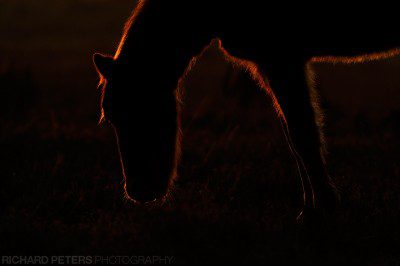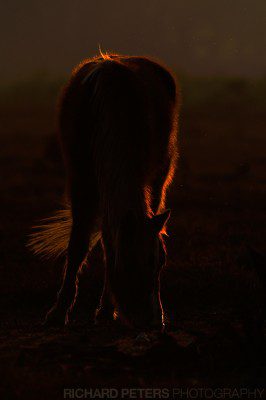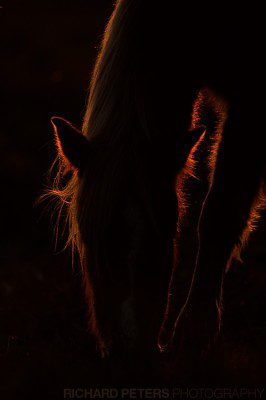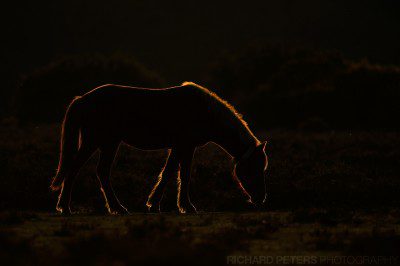Although these won’t be the last images you will see from my D3s, they are pretty much the last photos I’ll be shooting with it, as my D4 arrived the day after taking them. And so, these fiery rim lit silhouettes of the New Forest ponies were the perfect way to end my relationship with the old camera. If you haven’t been to the New Forest yet, I can’t recommend it enough. It’s a stunning part of the UK, but despite barely being an hour and a half from London I really don’t go there often enough. So, when my wife and I planned a mini break, I knew it would be a great chance to bring the 200-400 (my lens of choice when I’m ‘going light’) to try and capture an image I’ve wanted to get since the last time I was down there a few years ago – and this time around, the results were far more pleasing!

200-400 + 1.4x, 460mm, 1/1250, f7.1, -3.7, ISO 450
There are around 3000 ponies in the New Forest, left to roam freely (and they go everywhere, from the forests to the high streets of the villages!) and fend for themselves, although they are all owned by residents of the New Forest, so they are not truly wild. Regardless, they are lovely friendly animals and wild or not, seeing them in the stunning forest and heathland settings in good light is what makes the New Forest as special as it is. The last time I was there for a day trip, I tried to get a rim lit silhouette of one but the light just wasn’t right the end result was pretty dull, and so it’s been a shot I’ve wanted to take ‘properly’ ever since.

200-400 + 1.4x, 440mm 1/1250, f7.1 -3EV, ISO 220

200-400 +1.4x, 550mm, 1/1250, f7.1, -3.7, ISO 450
So, fast forward to 2012 and a mini break away for two nights, coinciding with excellent sunny weather, promised to provide the right conditions to finally nail the shot. The first evening, the conditions were not favourable, but the second evening proved to be quite the contrast and high up on the heathland I came across several ponies, positioned perfectly. And so, it was just a matter of waiting for the sun to drop lower in the sky, bringing with it some truly superb golden light. The trick to these types of shots is to get the sun behind the subject, but not directly behind, instead just a little out of frame to avoid too much light getting in the image and flattening the contrast. Then you need to make sure you’re shooting in to a dark background with no sky visible behind the subject. Using the 200-400 (read my review) I was able to move about freely without the need of a tripod getting in the way and is one of the reasons I call it my going light lens. To obtain the perfect rim lit silhouette I underexposed the images between 3 and 5 stops, and the results were exactly what I had envisioned all those years ago.

200-400 + 1.4x, 550mm, 1/1250, f7.1, -5.0, ISO 200
On the third evening, I found just one pony in the right position and although this one had a reflective collar on (a way of reducing the risk of them being run over at night) it kindly provided me with a nice full body shot against the shaded background, before it walked in to the shade itself and the rim light was lost. All in all, a wonderful end to the trip and a great way to say goodbye to the D3s which has served me very well over the last few years. It’s been with me everywhere from Yellowstone to New York to the incredible Farne Islands and it’s never missed a beat. I’ll be sad to see it go, but equally I’m looking forward to seeing what images I can capture with the D4.
If you want to head down there for yourself, you can find more information on the New Forest website.








